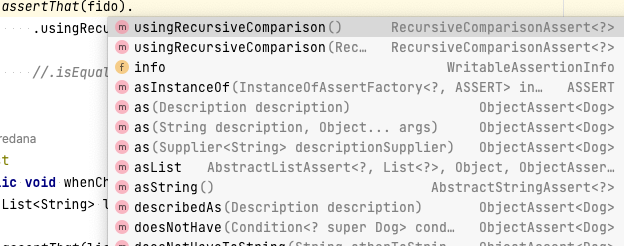About Assertions−4
Hamcrest gave us a good failure report and a readable test code style. But, the latter was relying on a Java’s language feature introduced in version 5.0, "static import".
If we don’t use it, the code will look like the following.
public class MultiConditions {
@Test
public void allOfMultiConditions() {
String firstName = "Gaius";
String lastName = "Caesar";
String helloMessage = composeHelloMessageInEnglish(firstName, lastName);
AllOf.assertThat(helloMessage, AllOf.allOf(
CoreMatchers.containsString("Hello"),
CoreMatchers.containsString("Gaius"),
CoreMatchers.containsString("CAESAR")));
}
}It doesn’t look like that much readable.
Another difficulty is that it is no that much "writable" for human.
This point isn’t mitigated by the static import.
The key methods, containsString, allOf, and assertThat are scattered in the entire namespace of your classpath.
You need to memorize the names of the static methods you want to use, more or less, even if your IDE helps you.
Unfortunately, there are quite a lot.
If you look into the source tree of the Hamcrest, perhaps you get scared by a troop of the classes[HamcrestGithub].
The approach by Google Truth and AssertJ
The most recent style of assertion libraries in Java as of 2022 is "fluent assertion style"[1].
public class AssertJExample {
public void assertJExampleFrodo() {
assertThat(frodo)
.isNotEqualTo(sauron)
.isIn(fellowshipOfTheRing);
}
public void assertJExampleFrodoName() {
assertThat(frodo.getName())
.startsWith("Fro")
.endsWith("do")
.isEqualToIgnoringCase("frodo");
}
public void assertJExampleFellowshipOfTheRing() {
assertThat(fellowshipOfTheRing)
.hasSize(9)
.contains(frodo, sam)
.doesNotContain(sauron);
}
}This is a snippet I created from the example I happened to find in [BaeldungAssertJ] and I edited to illustrate the concept.
The method assertThat is the entry point you must memorize, but it shouldn’t be difficult.
As soon as you type the code to call the method for an object you are about to verify, you will see a pop-up from your IDE.

Based on the type of the value you give, the list of the methods are shown. Thus, unlike you do not need to worry, which methods can be used for your value. Only available ones are shown there.
An output on a failure will be quite readable as Hamcrest.
org.opentest4j.AssertionFailedError: Expecting: <Your name> to start with: <Fro> but was not.
Style-wise, the same discussion is also valid for Google Truth [GoogleTruthGithub], and I am not going to provide a full example for it, here. It is generally considered that it has a simpler API structure [TruthVsAssertJ].
Next Post: Yet Open Problems
In the area of assertion libraries, I still see open problems. In the next two post, I will discuss what are still challenges that are not addressed even by AssertJ and Google Truth.